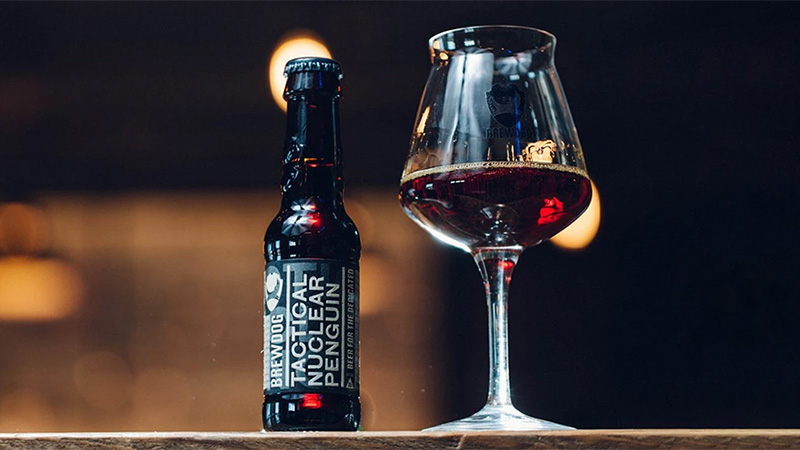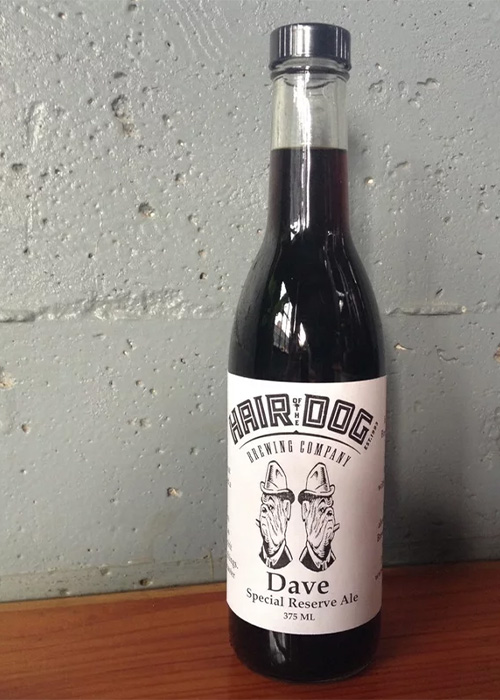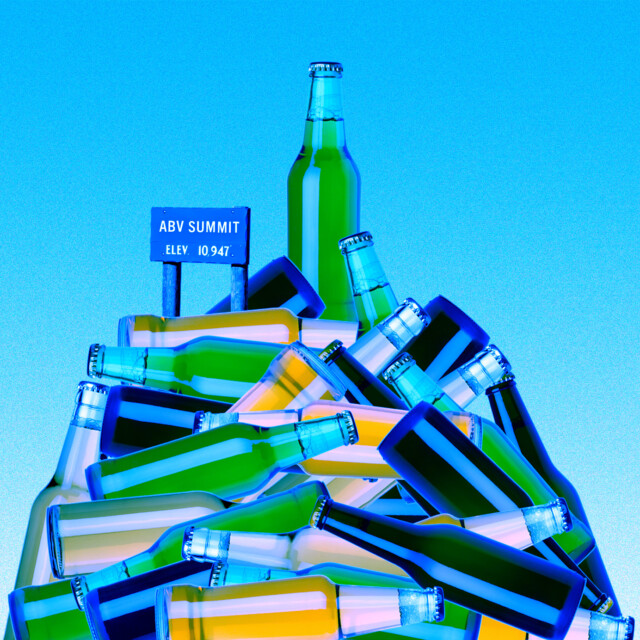April 16, 2009: A landslide in Kyrgyzstan kills 16 people. Bolivian police foil an international plot to assassinate President Evo Morales. And, in Fraserburgh, Scotland, BrewDog provocateurs James Watt and Martin Dickie dress up in penguin costumes to announce the release of the supposed “world’s strongest beer.”
If today Watt, Dickie, and BrewDog are seen as lame and out of touch, if not reprehensible, back in 2009 the upstart brewery was on the cutting edge of the industry. At the end of the aughts, that meant trying to push the envelope for how alcoholic a beer could be.
With their release of Tactical Nuclear Penguin, they had apparently reached the top of the mountain. Checking in at 32 percent ABV, this imperial stout was aged in two separate Scotch casks before “using a revolutionary and completely untested technique,” according to Dickie, and being stored for three weeks at minus 20 degrees Celsius at an ice cream factory to reach its final proof.
Though they released only 500 bottles, which sold for a jaw-dropping $169.99 each, beer drinkers of the time mostly respected the stunt, and reviews of the beer were pretty solid in an era when it wasn’t embarrassing to like a BrewDog beer.
As the Obama presidency began and the global financial crisis finally waned, high-octane beer was the spirit of the era.
An Epiphany
Of course high-ABV beers had been brewed before.
In fact, Samuel Adams’ co-founder Jim Koch had been obsessed with big beers pretty much since he started his pioneering craft brewery in 1984. This was an era when measly 4 percent ABV “lite” lagers had begun to take over, with Bud Light having just been introduced two years before.
In 1988 Samuel Adams released the company’s first-ever seasonal release, Double Bock, an American version of the malt-forward beers monks made for sustenance over Lent — it checked in at 9.5 percent ABV. Not particularly huge today, but massive in an era when the only other brews of this strength were much derided malt liquors like Olde English.
“It’s never sold well,” Koch once told me. Nevertheless, it’s one of the most awarded beers in Great American Beer Festival history.
And it would inspire Koch to go even bigger. At the time, it was believed among brewers that you pretty much couldn’t make a beer over 15 percent due to yeast constraints. The most alcoholic beers ever produced back then were thought to be the doppelbocks EKU 28 and Samichlaus, both right around that number.

In the early 1990s, Koch found himself wandering the aisles of his local Home Depot when he saw planters made of bourbon barrels cut in half. They were only 10 bucks.
“I had an epiphany!” Koch said. “I figured there were probably thousands of bourbon barrels coming out of Kentucky that had no second use.”
Empty bourbon barrels are of an incredible value today for “finishing” other spirits. But back then, the Kentucky distilleries and cooperages had no clue what to do with them. Oak barrels can only legally be used once to make bourbon, meaning there were tons of still wet barrels with no other use than as home for geraniums. Koch decided to put a bock in one.
The result, first released in 1994, was Samuel Adams Triple Bock. Checking in at 17.5 percent ABV, Koch had a fear he might get arrested; no one had ever combined beer and spirits in this way before. Luckily, though, he somehow got the government to approve it.
“As I drank it, I realized that no human being had ever drank something like this before,” Koch said. Rich and decadent, lacking in carbonation, and often described as more like a port, it was very thick as Koch’s brewers had trouble getting the fermentability up.
But the government wasn’t his only problem. MADD (Mothers Against Drunk Driving) protested the beer for being so boozy. Koch claimed he was being responsible by packaging it in tiny, cobalt blue 250 bottles and charging an astronomical $100 per case for it. Nor was it well reviewed — it currently scores a pathetic 69 out of 100 on Beer Advocate — with many noting a distinct taste of soy sauce, a typical flaw in higher-ABV stouts caused by dead yeast cells.
(For what’s it worth, I quite enjoyed a bottle of it I tried in 2016.)
Nevertheless, it inspired Koch and other brewers to go further.
A High-ABV Utopia
That same year, 1994, Hair of the Dog Brewery in Portland, Ore., released Dave, a 29 percent ABV barleywine. It was packaged in clear, 12-ounce bottles. By the 2010s, it was selling for $2000, one of the most ballyhooed beers in craft beer history.
There was Goose Island’s Bourbon County Brand Stout, the Chicago brewery’s 14-plus percent ABV monster inspired by Triple Bock and first released in 1995 (though, it wouldn’t be packaged in bottles until 2005).
Meanwhile, Triple Bock had sold well enough at the time to lead to new batches being released in 1995 and 1997. By then, Samuel Adams started holding back barrels, which were naturally rising in ABV due to evaporation. Likewise, the brewers had gotten better at high-ABV brewing techniques thanks to an alcohol-tolerant “ninja yeast” they had developed. As the year 2000 approached, Koch set a new goal for himself: a 20 percent beer to ring in Y2K.

With only a mere 3,000 bottles made of a “space age” plastic released, Samuel Adams Millennium would advance Triple Bock to 21 percent ABV with a less syrupy, much cleaner profile. It got rave reviews. But, its price was also $200 a bottle.
Nevertheless, it instantly sold out and Koch decided to continue his high-ABV quest. It was now the year 2002 and he obviously couldn’t keep the name Millennium. So he settled on Utopias, amused by its double meaning.
“I must bow before him for Utopias. I don’t think we’ll be brewing a beer that strong for a while.”
“You have the obvious meaning of a paradise,” Koch said, “but also the linguistic practical joke. Because in Greek, ‘utopia’ translates to ‘nowhere.’ Utopias was like that — a beer that had never existed before.”
A blend of various barrels from the brewery’s library, including a small percentage of that initial 1994 Triple Bock, Utopias clocked in at 24 percent ABV. It was packaged in a kettle-shaped porcelain bottle with a copper glaze, topped by screw-on lid, and — since it was uncarbonated — able to be drunk in several sittings. At $150 a bottle, it was often compared to port, sherry, or even Cognac.
Since that initial 2002 batch, there’ve been new releases pretty much every other year, with the ABV now bouncing around 28 to 30 percent (and the price up to $250). Starting around the 2009 release, just as craft beer was really starting to boom, Utopias finally received national buzz. That seemed to mostly be due to the headline-making fact that it was legally not allowed to be sold in around a dozen states.
Koch pooh-poohed these beers, calling them nothing more than “stunts” and perhaps not even beers per se thanks to the freeze distillation method. It didn’t matter.
“I must bow before him for Utopias,” Sam Calagione of Dogfish Head said at that time. His brewery had made beers like 120 Minute and World Wide Stout that challenged the 20 percent ABV mark, but he thought Utopias had reached a level that was now completely untouchable. “I don’t think we’ll be brewing a beer that strong for a while.”
However, other countries’ brewers were starting to notice how good these big beers were both for publicity and engineering new ways to up the ABV.
The End of Boozy History
In Bavaria, Germany, Georg Tscheuschner had become curious as to just how alcoholic he could possibly make a beer, though he would use a much different, German-inspired method compared to the American brewers. Trained at the prestigious Brewer Cursus Weihenstephan, Tscheuschner was now the brewmaster at a tiny Gunzenhausen outfit named Schorschbräu.
He first brewed a bock beer to 13 percent ABV before freezing it for four to five months. He then filtered out the ice crystals to remove water. (Because water has a lower freezing point than ethanol, the water freezes while the alcohol remains liquid.) This process of freeze concentration or freeze distillation was the same one that had traditionally been used to make Germany’s famous eisbocks (ice bocks).
By early 2009 Tscheuschner had released Schorschbräu Schorschbock 31%, packaged in a wooden box that boldly proclaimed “world strongest beer.” The gauntlet had been thrown down. BrewDog would fight back with its 32 percent ABV Tactical Nuclear Penguin. Schorschbräu would return the volley with Schorschbräu Schorschbock 40%. Then came BrewDog’s 2010 beer Sink the Bismarck at 41 percent, followed by Schorschbräu Schorschbock 43%.
Koch pooh-poohed these beers, calling them nothing more than “stunts” and perhaps not even beers per se thanks to the freeze distillation method. It didn’t matter. Nor did it matter whether these beers were any good, nor if your average consumer would ever try them. They were great fodder for online content churners who need to quickly slap together listicles and news articles. And, whoa boy, were listicles written. It helped the breweries’ sales, too.
“It’s a friendly contest that has already brought me new customers,” claimed Tscheuschner.
Though, Koch was clearly right — the boozy beer wars had become a publicity stunt by this point.
The proverbial shark was fittingly jumped by BrewDog’s 2010 release The End of History, a 55 percent ABV offering with a bottle count of only 12 — although the beer actually came in a taxidermied squirrel. Costing $765, I’ve never met someone who has tried it.
By this point, even craft beer hype lords were getting tired of these stunts and End of History was much maligned in beer forums. Though further “strongest beer ever” entrants would arrive over the next few years — 2010’s Brouwerij ‘t Koelschip Start The Future (60 percent ABV), 2012’s Brewmeister Armageddon (65 percent ABV), and 2013’s Brewmeister Snake Venom (67.5 percent ABV) — there was little interest any more. And, anyhow, the craft brewing industry was moving away from boozy beer for boozy beer’s sake.
With the 2010 release of Mikkeller 1000IBU IPA, it was now time to see who could make… the world’s hoppiest beer.
